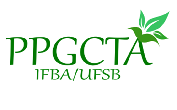Banca de DEFESA: WINNIE AGUIAR VIRGENS
Uma banca de DEFESA de MESTRADO foi cadastrada pelo programa.DISCENTE : WINNIE AGUIAR VIRGENS
DATA : 13/07/2021
HORA: 09:00
LOCAL: Sala virtual com link de transmissão meet.google.com/qcs-sknk-nrv
TÍTULO:
Floristics, Phytogeography and Conservation in the Atlantic Forest: an experience in the cabrucas of the Pau-Brasil Settlement, Extreme South of Bahia
PALAVRAS-CHAVES:
Cocoa; Plant diversity. Submontane Ombrophilous Forest. Bahian Hileia. Bioeconomy.
PÁGINAS: 112
GRANDE ÁREA: Outra
ÁREA: Ciências Ambientais
RESUMO:
The Ombrophilous Forest strip belonging to the south of Bahia and the north of Espírito Santo is one of the main centers of endemism in the Atlantic Forest and has a vast richness of species. The cabruca system ensured a large part of the conservation of the region's biodiversity and wealth. The Pau-Brasil Settlement, Itamaraju-BA, has an area of 325 ha with cabruca cacao, established about 90 years ago. The objective of this research was to carry out the floristic characterization of the fragments with cocoa plantations in the area, to conduct a phytogeographic analysis, by comparing the place with the florists of other places in the Atlantic Forest and to elaborate a list of tradable native species, for generation of residents' income. The floristic survey was carried out from January 2019 to January 2020, through 32 collection expeditions. For identification, specialized literature, collection of herbariums and consultation with specialists were used. The classification of vegetation and phytophysiognomies followed the Technical Manual of Brazilian Vegetation and the analysis of the collected flora. The floristic comparison with other Atlantic Forest fragments was performed by similarity, using the Jaccard index (SJ) and the UPGMA mean association method for clustering, conducted in the PAST 3.09 software. The scientific names were checked and updated following Flora do Brasil 2020 online and IPNI. For the list of marketable native species, a literature search was carried out based on the potential use (eg medicinal, wood, food) of the species. Documents were collected on the Google Scholar platform. Then, a ranking of the species was generated, using the Index of Ranking (Ranking) to classify those with the greatest number of uses. The best ranked species were analyzed on the Web of Science, Portal Periódicos CAPES, Scopus and SciELO platforms in the period 2010-2020 and the Use Value (UV) was calculated. 1,800 samples were collected belonging to 96 families, 253 genera and 366 species, registered in four phytophysiognomies, inside cabruca sites: 1) cabrucas in forests; 2) cabrucas in riparian forests; 3) rock outcrop vegetation; and 4) cabrucas in disturbed areas. Four new species were found belonging to the families Araceae (2 spp.), Connaraceae (1 sp.) and Salicaceae (1 sp.), 67 spp. endemic to the Atlantic Forest biome and 15 spp. endangered. The vegetation is characterized as Submontane Dense Ombrophilous Forest and the settlement was grouped with a protected area of Sustainable Use: RPPN Serra do Teimoso Natural Reserve; but the floristic analysis showed low similarity between the fragments, confirming the heterogeneity of the biome. The search on Google Scholar gathered 4,476 materials and on the other platforms 4,106, with information on 159 (69%) of the 231 native species analyzed. 13 categories of uses were found and 29 species were selected with the highest Ordering Indexes (OI = 0.0013 to 0.0024). Among the species with the greatest multiplicity of uses are Eugenia uniflora (pitanga), Bixa orellana (annatto) and Eschweilera ovata (biriba) (VU = 0.0003- 0.0017).
MEMBROS DA BANCA:
Interna - 034.751.739-05 - CAROLINA WEBER KFFURI - UFSB
Interno - 1782304 - JAILSON SANTOS DE NOVAIS
Presidente - 1553832 - JORGE ANTONIO SILVA COSTA
Externa ao Programa - 1149467 - TAINA SORAIA MULLER



